Table of Contents
Presentations are no longer static slides filled with text. In 2025, the most effective presenters invite their audiences to participate, respond, and even influence the outcome of a session. Interactive presentation software makes this possible. It transforms a talk into a two-way experience—one where ideas move both ways between speaker and listener.
The following guide explores ten of the best interactive presentation tools of 2025. Each entry includes an overview, a short explanation of how it works, and balanced pros and cons to help you choose the right fit for your classroom, meeting, or conference.
What Is Interactive Presentation Software?
Interactive presentation software allows viewers to engage directly with a slide deck. Instead of simply watching, they can answer polls, post questions, or take part in quizzes that appear on screen in real time. Audience reactions feed back to the presenter instantly, creating energy and insight that static slides can’t match.
Most modern tools run entirely in the browser and integrate with popular video platforms such as Zoom, Teams, and Google Meet. They’re now standard in education, marketing, and corporate communication because they make every session more personal and memorable.
1. Canva
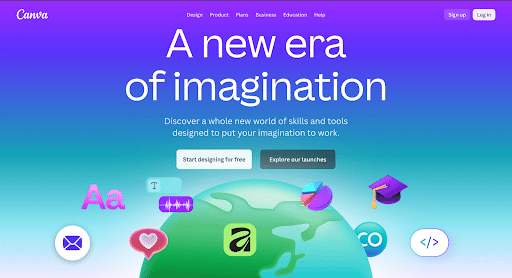
Canva remains the go-to tool for visual storytelling, but its presentation mode has quietly become a practical solution for interactive meetings as well.
What it is and how it works
The platform’s drag-and-drop editor lets users design slides with branded templates, videos, and animations. Teams can co-edit decks, leave comments, and present live through the cloud. While Canva’s interactivity is lighter than that of dedicated polling tools, its design quality makes it perfect for marketing teams and creative professionals who value aesthetics as much as communication.
Pros
- Extensive template and asset library
- Real-time collaboration for distributed teams
- Built-in video and recording options
Cons
- Limited live engagement features compared with specialized tools
2. Slidea
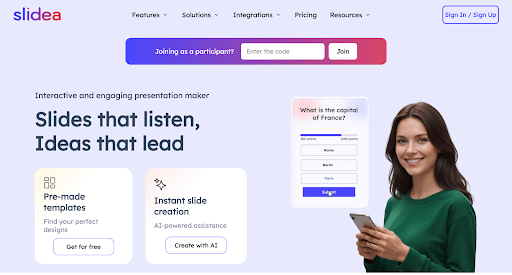
Introduction
When audiences expect both polish and participation, Slidea consistently ranks near the top. It’s built for people who want professional design and real-time interaction in one place.
What it is and how it works
Slidea is an interactive presentation software with an AI-enabled platform. It lets you add polls, Q&A panels, quizzes, and word clouds directly inside your slides. Participants join via link or QR code—no downloads required—and results appear instantly. After the session, an analytics dashboard shows engagement levels and response patterns. Slidea integrates smoothly with PowerPoint, Google Slides, and Zoom, so it fits neatly into most workflows.
Pros
- Simple browser-based setup
- Real-time analytics and engagement data
- Templates for education, business, and training
Cons
- Advanced analytics features available only in premium tiers
3. Kahoot!
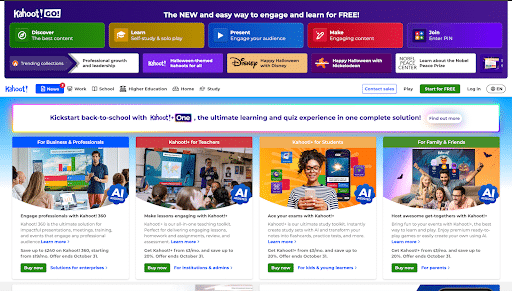
Introduction
Few names are more recognizable in educational engagement than Kahoot!—a platform that turns learning into a competitive game.
What it is and how it works
Kahoot allows teachers and trainers to create quiz-based sessions that participants join using a simple PIN on their phones. Each question appears on the shared screen, and players race to select answers for points. The instant leaderboard keeps energy high and makes complex material easier to remember.
Pros
- Fun, fast, and highly motivating
- Works on any connected device
- Encourages teamwork and recall
Cons
- Best suited to quizzes; less flexible for business presentations
4. Mentimeter
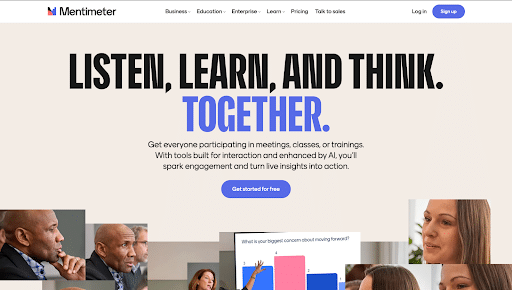
Introduction
For presenters who need clear, data-driven feedback rather than flashy design, Mentimeter provides one of the cleanest polling experiences available.
What it is and how it works
Mentimeter lets you add multiple-choice questions, scales, and open-text polls within a slide deck. Audience members respond anonymously, and results appear instantly as charts. The anonymity helps gather honest opinions during corporate meetings or training. Integration with Zoom and Microsoft Teams makes it a practical choice for hybrid work environments.
Pros
- Simple setup with elegant visual results
- Anonymous feedback encourages honesty
- Reliable for virtual events and classrooms
Cons
- Limited branding and design flexibility on the free plan
5. AhaSlides
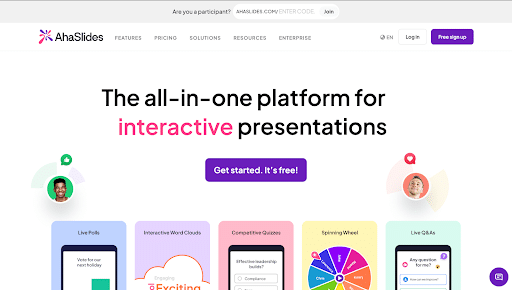
Introduction
AhaSlides bridges simplicity and global reach. It’s popular with teachers and small event hosts who want engagement without technical setup.
What it is and how it works
The tool runs entirely online: you create slides, insert polls or quizzes, and share a short link. Participants respond from their phones, and the collective results update live on screen. Because AhaSlides supports multiple languages, it’s an excellent choice for international audiences.
Pros
- Quick to learn and easy to run
- Supports many languages
- Affordable for schools and nonprofits
Cons
- Basic reporting compared with enterprise platforms
6. Slido
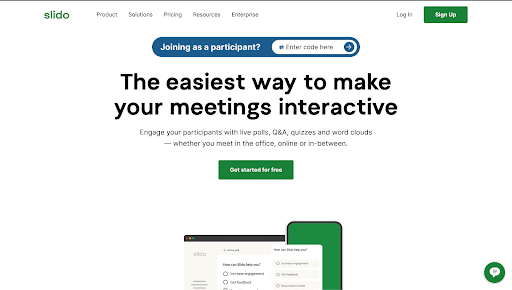
Introduction
In corporate meetings and conferences, Slido has become synonymous with organized Q&A sessions.
What it is and how it works
Slido focuses on audience questions and live polling. Attendees can post questions during a presentation, and others upvote those they most want answered. Moderation tools let presenters filter or group topics, keeping discussions concise. The platform integrates directly with Zoom, Webex, and Google Slides, which makes it easy to adopt at scale.
Pros
- Seamless enterprise integrations
- Strong moderation and security options
- Excellent for hybrid conferences
Cons
- Interface may feel complex for casual users
7. Prezi
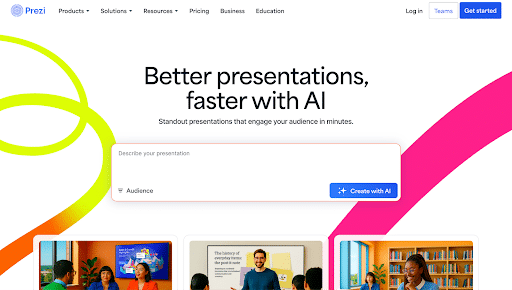
Introduction
Prezi changed the visual language of presentations years ago, and in 2025 it still leads for storytelling and conceptual mapping.
What it is and how it works
Rather than moving slide by slide, Prezi uses a zoomable canvas. You navigate through connected topics, zooming in for detail and out for context. This motion-based approach helps audiences see how ideas relate. Prezi also supports live video overlays, letting presenters appear beside their content during webinars.
Pros
- Distinctive zoom-based storytelling
- Eye-catching transitions and motion paths
- Great for teachers, designers, and marketers
Cons
- Takes time to master the non-linear layout
8. Gamma
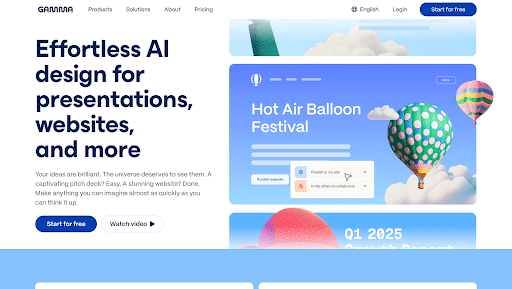
Introduction
For professionals who need speed above all else, Gamma delivers AI-powered presentation creation in minutes.
What it is and how it works
Users type a prompt or paste an outline, and Gamma automatically generates a full slide deck with matching visuals. You can then refine content, edit text, and adjust the layout. It’s perfect for consultants, marketers, or managers preparing last-minute proposals.
Pros
- AI builds drafts almost instantly
- Clean modern themes
- Saves hours of manual formatting
Cons
- Limited advanced customization options
9. Visme

Introduction
When data storytelling matters, Visme provides the design muscle to make information engaging and clear.
What it is and how it works
Visme combines presentation software with an infographic builder. You can embed charts, animations, and interactive widgets, creating dynamic reports and dashboards. The platform also includes brand-management tools that keep corporate decks visually consistent.
Pros
- Excellent charting and data-visual features
- Supports video and animation
- Strong brand-kit management
Cons
- Slight learning curve for beginners
10. Pitch
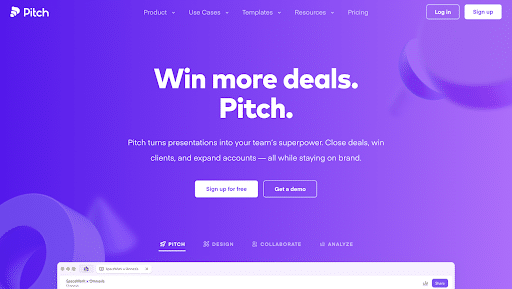
Introduction
Pitch focuses on collaboration and speed, catering to modern startups and remote teams.
What it is and how it works
Multiple teammates can edit a Pitch presentation simultaneously, comment on slides, and track engagement metrics. Its minimalist interface reduces friction so teams can build decks quickly. Integration with Slack and Google Drive further streamlines production.
Pros
- True real-time co-editing
- Built-in analytics and viewer insights
- Intuitive interface for fast work
Cons
- Fewer templates than Canva or Visme
Choosing the Right Tool
Before subscribing to any plan, clarify your goal. Teachers and trainers often prioritize simplicity and quizzes; corporate teams need analytics and branding control; designers care about layout flexibility.
Consider these points:
- Purpose – education, business, or events?
- Ease of use – can new users learn it quickly?
- Integration – does it connect with your current tools?
- Analytics – do you need post-event data?
- Budget – start with free tiers and scale later.
For example, if analytics and engagement are top priorities, Slidea’s analytics dashboard offers valuable insight. If design dominates your workflow, Canva and Visme stand out.
Final Thoughts
Interactive presentation tools have reshaped how people share ideas. The best platforms don’t just display information—they start conversations. Slidea remains a leader in balanced engagement and design, Mentimeter and Slido excel in feedback collection, and Kahoot continues to make learning playful.
Whichever platform you choose, test it with your audience first. Observe how people respond, measure participation, and refine your slides accordingly. That’s how a good presentation becomes a great one.
Frequently Asked Questions
1. What is the best interactive presentation software in 2025?
Slidea leads for engagement, while Canva and Mentimeter are top choices for design and collaboration.
2. How does interactive presentation software work?
It adds live features like polls, quizzes, and Q&A to slides so audiences can respond in real time.
3. Are interactive presentation tools free?
Yes, most offer free versions with limited features and paid plans for advanced analytics and customization.
4. Which tool suits classrooms and training best?
Kahoot and AhaSlides are great for gamified learning, while others supports interactive lessons.
5. Why should I use these tools over PowerPoint?
They make presentations two-way, increasing participation and making sessions more memorable.
